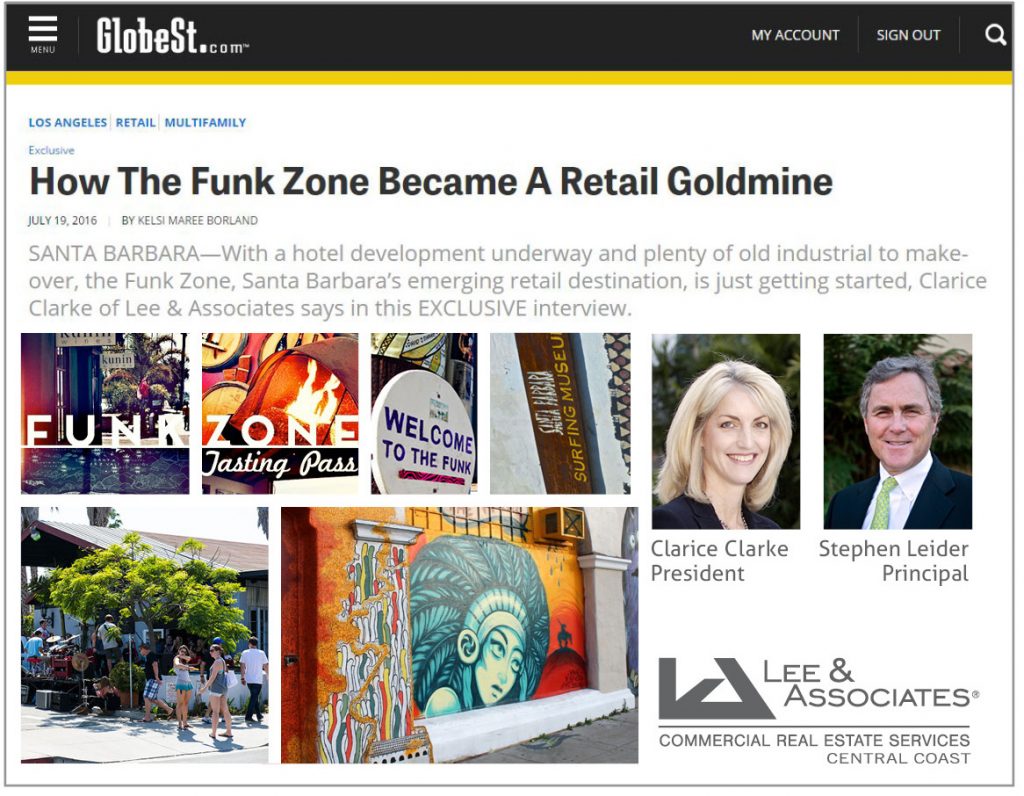How The Funk Zone Became A Retail Goldmine
SANTA BARBARA—With a hotel development underway and plenty of old industrial to make-over, the Funk Zone, Santa Barbara’s emerging retail destination, is just getting started, Clarice Clarke of Lee & Associates says in this EXCLUSIVE interview.
“It is the center of the universe right now,” Clarice Clarke, the president of Lee & Associates Central Coast office, says about the Funk Zone, a submarket of Santa Barbara that runs from the ocean to the freeway. The neighborhood is booming, with thriving retail and loads of new development, including high-end condo complexes and hotels. It is akin to the revolution happening in Dow ntown Los Angeles, but is also pulling demand away from historically popular Santa Barbara submarkets, like State Street, in a way that Downtown Los Angeles hasn’t been quite able to pull off yet.
ntown Los Angeles, but is also pulling demand away from historically popular Santa Barbara submarkets, like State Street, in a way that Downtown Los Angeles hasn’t been quite able to pull off yet.
“The Funk Zone is a great example of repurposing, and it is really an interesting phenomenon. It used to be fish processing plants and wood working studios, and all kinds of industrial uses,” Clarke tells GlobeSt.com. “Beacon’s Moving and Storage building was one thing that started the transformation of the area. It was right on the railroad tracks, and we sold it to a buyer that flipped it to a local investor that bought some other key pieces in the Funk Zone. That really started a whole revolution down there.”
While Downtown Los Angeles had the adaptive reuse ordinance, which helped to catapult development in the submarket, zoning in the Funk Zone is much more of an obstacle. It was formerly an industrial market, and the city has kept the zoning regulations pretty strict. “The market has very challenging zoning, even today,” says Clarke. “It is in the coastal zone, and any property has to be ocean-related commercial and tourist serving. Some parts of the area have a housing overlay, and that is it.”
Clarke and her partner Steve Leider, a principal in Lee & Associates Central Coast, are well aware of the zoning struggles in the market. The duo attempted to buy a building in the Funk Zone more than a decade ago. “We were going to put our office in the back and rent out the retail space, but when we went to the city, they said no office,” says Leider.
While there is little office space in the market, interesting and boutique retail concepts have exploded. The Lark is perhaps the most noteworthy of a handful of high-volume restaurants flanked by wine tasting rooms. There are also two high-end condo developments under construction. Those units will carry price tags starting at $3 million once complete. “The biggest thing that you will see down there is the redevelopment of La Entrada, which encompasses three corners,” says Clarke. “Michael Rosenfeld, the developer, is building a new hotel with retail across the street and a parking garage on the opposite corner.”
Much of this development will come on line in the next few years, and will unveil the next evolution in the market; however, Clarke points to a number of untouched industrial facilities and lots that have yet to join the movement. Some owners are holding out for higher prices,” she explains, adding that they will sell, eventually. With those lots, which are substantial in number, the Funk Zone has plenty of development runway left.
